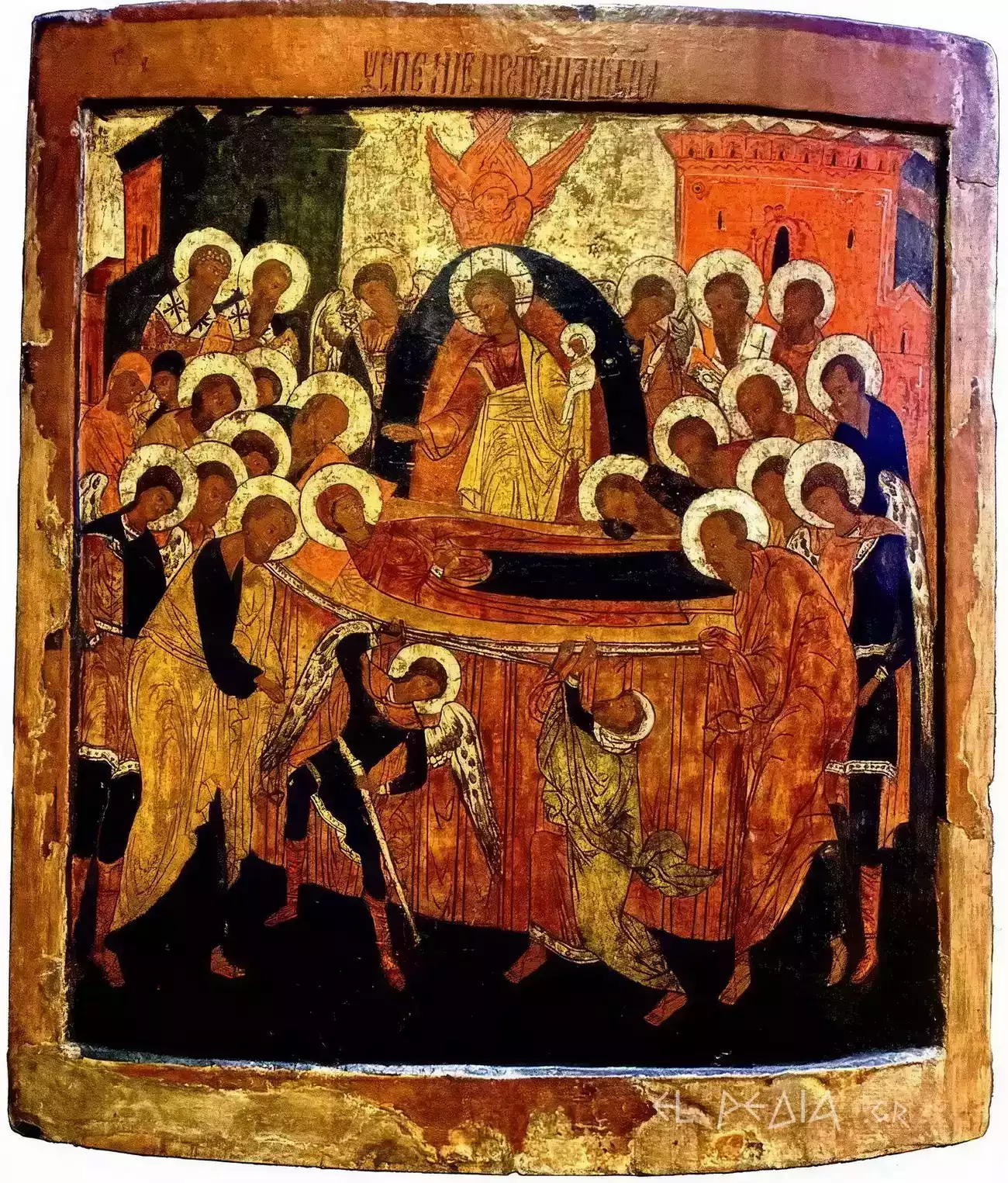
Title: The Dormition of the Theotokos
Artist: Unknown Iconographer of the Novgorod School
Type: Russian Orthodox Icon
Date: circa 1650
Dimensions: Unknown
Materials: Egg tempera and gold leaf on wooden panel
Location: Museum of Russian Icons, Clinton, Massachusetts, USA
The Image of the Dormition in Clinton is an excellent example of Russian iconographic art of the 17th century, originating from the renowned Novgorod School. The work depicts the Dormition of the Theotokos, one of the most significant events in the liturgical cycle of the Orthodox Church. The composition is characterized by the traditional hierarchical arrangement of figures, with Christ at the center holding the soul of the Virgin, surrounded by Apostles and angels. The use of the golden background and vivid colors, especially red and blue, creates a transcendent atmosphere that characterizes the Russian iconographic tradition. The style of the work reflects the Novgorod school, which is distinguished by its expressive power and simple elegance.
Iconographic Analysis and Symbolism
The image of the Dormition presents an exceptionally hierarchical composition that faithfully follows the established iconographic tradition of the Orthodox Church. At the center of the composition dominates the deathbed of the Theotokos, around which the Apostles gather in a posture of deep reverence. The central figure of Christ, dressed in a gold-embroidered robe, holds in his hands the soul of the Virgin, depicted as a swaddled infant, symbolizing spiritual rebirth.
The scene takes place in an architectural setting suggested by two symmetrical buildings in the background, a characteristic element of Russian iconography of the time (Ruzsa). The Apostles, arranged in two groups on either side of the bed, are depicted with expressive intensity that characterizes the Novgorod School. Particular emphasis is placed on the gestures and postures of the figures, expressing their deep mourning.
At the top of the composition, a group of angels surrounds Christ, creating a dynamic movement that leads the eye to the central scene. The use of the golden background, a characteristic element of Russian iconography, creates a transcendent atmosphere that underscores the spiritual nature of the event. The vivid colors of the garments, mainly deep red and dark blue, reflect the tradition of the Novgorod School.
The image also includes secondary episodes that enrich the main narrative, such as the arrival of the Apostles on clouds and the presence of Jephonias, the Jewish priest who attempted to overturn the deathbed. These details, although secondary, contribute to the completeness of the narrative and the understanding of the theological message of the image, while maintaining the artistic coherence of the composition.
The composition is characterized by an exceptional balance between the strict hierarchical arrangement and the emotional intensity of the figures, an element that highlights the mastery of the unknown artist of the Novgorod School.

Stylistic Features and Artistic Significance
The image of Clinton presents unique stylistic features that make it a representative example of Russian iconographic art of the 17th century. Egg tempera and gold leaf on a wooden panel are the main materials used, following the traditional technique of iconography in Siberia (Velizhanina).
The technical execution of the work reveals exceptional skill in rendering details, especially in the treatment of the faces and garments of the figures. The color palette, dominated by the warm tones of red and gold in contrast to the cool blues, creates an impressive color harmony that characterizes the Novgorod School of the 17th century, while the highly skillful use of perspective in rendering architectural elements and the detailed treatment of decorative motifs highlight the artist’s mastery in organizing the iconographic space.
The handling of light and shadow follows the established conventions of Russian iconography, where light does not come from a natural source but is an inherent characteristic of the figures, creating a transcendent atmosphere that transcends the limitations of physical space and time. This technical approach, which combines traditional iconographic language with elements of artistic innovation, makes the work particularly significant for understanding the evolution of Russian iconography.
Noteworthy is the artist’s ability to combine the strictness of traditional iconography with an expressive vitality in rendering the figures, creating a composition that, despite its liturgical character, maintains a sense of human immediacy. The delicate balance between typical iconographic tradition and artistic originality highlights the skill of the unknown iconographer and his ability to enrich tradition with personal elements of expression.
The Image of the Dormition in Clinton as a Masterpiece
The image of the Dormition in Clinton represents an outstanding example of Russian iconographic art of the 17th century, combining traditional technique with a unique artistic sensitivity. Its contribution to understanding the evolution of Russian iconography is invaluable, as it serves as a bridge between Byzantine tradition and local artistic expressions.
Its presence in the Museum of Russian Icons in Clinton offers visitors a unique opportunity to understand the significance of Russian iconographic art and its evolution over the centuries. The excellent preservation and high artistic quality of the work make it a valuable document for the study of the art of the period.
The work remains a timeless example of the ability of artists to translate spiritual concepts into visual language, while maintaining the artistic integrity and technical excellence that characterize great works of art.
elpedia.gr
Bibliography
Khodakovsky, Evgeny. Wooden Church Architecture of the Russian North: Regional Schools and Traditions (14th-19th centuries). Taylor & Francis, 2015.
Ruzsa, G. The Use and Role of Metals in Art of Russian Icons. Technology, Materials, Symbolism, Sacral References.” Slavica 44 (2015): 87-98.
Velizhanina, N.G. “On the History of Icon Painting in Western Siberia.” In Russian Traditional Culture. Taylor & Francis, 2016.

